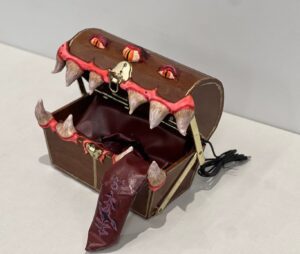
The Games and Interactive Media (GaIM) Maker Space, at UCF Downtown, presents the Physical Computing (DIG 3602) project Mimic Controller, created by John Collera and Anthony Caruso.
Using tools and materials provided by Maker Space, they created a functional mimic controller for the game Crypt of the NecroDancer, a game in which the player traverses a dungeon to the rhythm of the music playing in the background. The controller is designed to look and function like a Mimic; a classic medieval fantasy monster which also appears in the game itself. The player themself must face the strange depths of this creature to be able to brave the depths of the dungeons in the game. Alternate controllers, like this, are a way to engage more or provide accessibility with games or game-like experiences.
By design, Crypt of the NecroDancer has a simple control layout, primarily only using the arrow keys of a keyboard. Because of this, players can engage with the game more readily by controlling three of the Mimic’s fleshy bits. The tongue can be used to move up or down, as well as throwing your weapon. The inside of the Mimic possesses two sores that can be pressed on to move the player left or right. Inputs can also be combined to perform their respective actions in game, which are meant to be discovered easily by the way they stick out compared to the rest of the Mimics body; both in terms of texture as well as proportions.
In terms of material affordances, a linear potentiometer was used to help grant the aesthetics they wanted to achieve. The physical build used 3D printing filament to create the body, which was spray painted over, and Copic Ink markers were used to simulate wood grain. Gold metal hinges made the Mimic more compelling both in aesthetics and functionality. Living details like the eyes, teeth, tongue, and gums, used air-dry foam clay and alcohol-based markers. The inner mouth and tongue texture have a red vinyl fabric. Lastly, the squishy sores in the mouth and on the back of the tongue used children’s mochi squishy toys to achieve its texture.
Written by Jordan Lipscomb.
Published to Nicholson News on February 4th, 2025.
If you have any news, accomplishments or highlights about your work or life, please be sure to share them with us, by emailing us at NicholsonNews@ucf.edu.